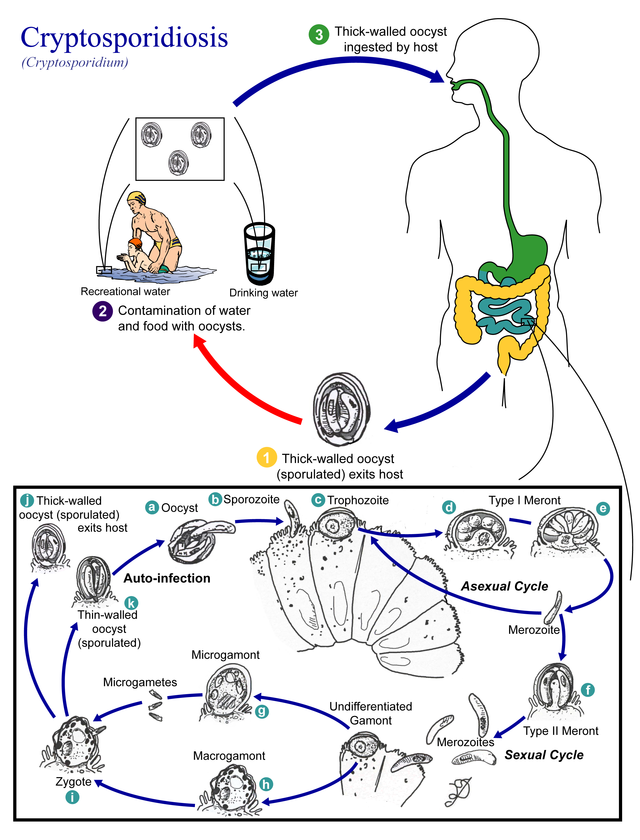Top Qs
Timeline
Chat
Perspective
Cryptosporidium
Genus of single-celled organisms From Wikipedia, the free encyclopedia
Remove ads
Cryptosporidium, sometimes called crypto, is an apicomplexan genus of alveolates which are parasites that can cause a respiratory and gastrointestinal illness (cryptosporidiosis) that primarily involves watery diarrhea (intestinal cryptosporidiosis), sometimes with a persistent cough (respiratory cryptosporidiosis).[1][2]
This article is missing information about effects of Cryptosporidium infection on groups of animals other than mammals. (August 2023) |
Treatment of gastrointestinal infection in humans involves fluid rehydration, electrolyte replacement, and management of any pain. For cryptosporidiosis, supportive treatment and symptom management are the primary treatments for immunocompetent individuals.[3] Anti-diarrheal medication, such as Loperamide, may be effective in slowing the rate of diarrhea. Nitazoxanide is the only drug approved for the treatment of cryptosporidiosis in immunocompetent persons.[4] Supplemental zinc may improve symptoms,[5] particularly in recurrent or persistent infections or in others at risk for zinc deficiency. Cryptosporidium oocysts are 4–6 μm in diameter and exhibit partial acid-fast staining. They must be differentiated from other partially acid-fast organisms including Cyclospora cayetanensis.
Remove ads
General characteristics
Summarize
Perspective
Cryptosporidium causes cryptosporidiosis, an infection that may present as a diarrhea, sometimes with a persistent cough in immunocompetent hosts.[clarification needed][1] Other apicomplexan pathogens of humans include the malaria parasite Plasmodium and the toxoplasmosis parasite Toxoplasma. Unlike Plasmodium, which transmits via a mosquito disease vector, and Toxoplasma which needs a feline as definitive host,[6] Cryptosporidium does not use a vector, and is capable of completing its lifecycle within a single host. It results in cyst stages that are excreted in feces or through inhalation of coughed on fomites and are capable of transmission to a new host.[1][7][8]
A number of species infect mammals. In humans, the main causes of disease are C. parvum and C. hominis (previously C. parvum genotype 1). C. canis, C. felis, C. meleagridis, and C. muris can also cause disease in humans.[7]
Cryptosporidiosis is typically an acute, short-term infection, but can recur through reinfection in immunocompetent hosts, or become severe or life-threatening in immunocompromised individuals. In humans, it remains in the lower intestine and may remain for up to five weeks.[7] The parasite is transmitted by environmentally hardy cysts (oocysts) that, when ingested, remain in the small intestine and cause an infection of intestinal epithelial tissue.[7] Transmission by ingestion or inhalation of coughed-on fomites is a second, less likely route of infection.[1]
The genome of C. parvum, sequenced in 2004, was found to be unusual amongst eukaryotes in that the mitochondria seem not to contain DNA.[9] A closely related species, C. hominis, has also had its genome sequenced.[10]
Remove ads
Life cycle

Cryptosporidium has three developmental stages: meronts, gamonts and oocysts.[11] They reproduce within the intestinal epithelial cells.[12] The Cryptosporidium spore phase (oocyst) can survive for lengthy periods outside a host. It can also resist many common disinfectants, including chlorine-based disinfectants.[13]
Water treatment and detection
Summarize
Perspective
Many treatment plants that take raw water from rivers, lakes, and reservoirs for public drinking water production use conventional filtration technologies. Direct filtration, which is typically used to treat water with low particulate levels, includes coagulation and filtration but not sedimentation. Other common filtration processes including slow sand filters, diatomaceous earth filters, and membranes will remove 99% of Cryptosporidium.[14] Membranes and bag- and cartridge-filter products remove Cryptosporidium specifically.
Cryptosporidium is highly resistant to chlorine disinfection;[15] but with high enough concentrations and contact time, Cryptosporidium inactivation will occur with chlorine dioxide and ozone treatment. In general, the required levels of chlorine preclude the use of chlorine disinfection as a reliable method to control Cryptosporidium in drinking water. Ultraviolet light treatment at relatively low doses will inactivate Cryptosporidium.[16][17]
One of the largest challenges in identifying outbreaks is the ability to verify the results in a laboratory. The oocytes may be seen by microscopic examination of a stool sample, but they may be confused with other objects or artifacts similar in appearance.[18] Most cryptosporidia are 3–6 μm in size, although some reports have described larger cells.[18]
Boiling is believed to be the safest option for water contaminated by Cryptosporidium.[19][20][21]
Epidemiology
Summarize
Perspective
Exposure risks
- People who swim regularly in pools with insufficient sanitation (certain strains of Cryptosporidium are chlorine-resistant)
- Child-care workers
- Parents of infected children
- People caring for other people with cryptosporidiosis
- Backpackers, hikers, and campers who drink unfiltered, untreated water
- People who visit petting farms and open farms with public access[22][23]
- People, including swimmers, who swallow water from contaminated sources
- People handling infected cattle
- People exposed to human feces
- People who turn compost that has not gone through its phase where temperatures over 50 °C are reached[24]
Dealing with stabilized compost – composting material that has gone through the phases where micro-organisms are digesting the organic matter and the temperature inside the composting pile has reached temperature up to 50–70 °C – poses very little risk as these temperatures kill pathogens and make oocysts unviable.[24]
Like many fecal-oral pathogens, the disease can also be transmitted by contaminated food, poor hygiene or turning compost in a local compost site. Testing of water, as well as epidemiological study, are necessary to determine the sources of specific infections. Cryptosporidium typically does not cause serious illness in healthy people. It may chronically sicken some children, as well as adults exposed and immunocompromised.
Remove ads
Species
- Cryptosporidium andersoni
- Cryptosporidium bailey
- Cryptosporidium bovis
- Cryptosporidium cervine
- Cryptosporidium canis
- Cryptosporidium cuniculus
- Cryptosporidium ducismarci
- Cryptosporidium fayeri
- Cryptosporidium felis
- Cryptosporidium fragile
- Cryptosporidium galli
- Cryptosporidium hominis
- Cryptosporidium marcopodum
- Cryptosporidium meleagridis
- Cryptosporidium molnari
- Cryptosporidium muris
- Cryptosporidium parvum
- Cryptosporidium ryanae
- Cryptosporidium saurophilum
- Cryptosporidium serpentis
- Cryptosporidium suis
- Cryptosporidium ubiquitum
- Cryptosporidium viatorum
- Cryptosporidium wrairi
- Cryptosporidium xiaoi
Remove ads
See also
References
Further reading
External links
Wikiwand - on
Seamless Wikipedia browsing. On steroids.
Remove ads

